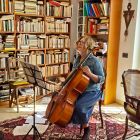Rescuing Villa dei Papiri
The famous Villa dei Papiri at Herculanum has finally opened, more than 200 years after it was first located by archaeologists. The luxurious patrician villa, which was built on a series of terraces overlooking the sea, was swallowed up in the eruption of Vesuvius in 79 AD when it was buried under 30 m of volcanic silt. Tragic as this was for the villas inhabitants, it had the effect of preserving their memory for eternity. At Herculanum, which was seven km from Vesuvius, the volcanic fall-out mixed with sea water and solidified, preserving fragile materials like wooden beams, scraps of linen and the upper storeys of many buildings. It also saved a unique treasure: over 1,000 papyrus scrolls, which were the contents of the library of a magnificent noble house on the outskirts of the town.
The villa, which has taken its name from this extraordinary find, was first located in the 18th century by archaeologists who were employed by the Bourbon kings of Naples to explore the buried cities of Pompeii and Herculanum. They dug down into the interior through a series of tunnels and shafts, recovering a cache of 50 bronzes, 21 marble sculptures, mosaic pavements and frescoes, now kept in the Museo Archeologico Nazionale in Naples. They also found a rare collection of first-century BC Greek and Latin texts, which are preserved in the national library in Naples.
However in 1765 the archaeologists were forced to abandon the task because of the poisonous gases which infiltrated the passages. Fortunately, the Swiss engineer Carl Weber, who worked on the project for almost 15 years, had drawn up two detailed and accurate plans illustrating the layout of the villa. He meticulously documented the exact spots where all the works of art were found and marked the position of the various access shafts and tunnels which had been created. This not only facilitated the work of future generations of explorers, but it also formed the basis of what came to be considered the villa perfecta, or ideal Roman retreat. The plan was copied last century by oil magnate Paul Getty when he built his Malibu Palace, now the seat of the Getty Museum.
The present excavations started in 1996 and involved removing volcanic deposits 30 m deep. There are considerable problems involved in maintaining the site, as the area is now below sea level and has to be continually pumped to prevent flooding.
The original villa was a vast palace, 250 m long and built on different levels. It commanded magnificent views of the gulf and was complete with all the comforts a wealthy Roman aristocrat would expect. It had columned walkways and courtyards, frescoed halls, split-level gardens, a belvedere and a swimming pool over 66 m long.
Archaeologists are not sure about the identity of the owner, but evidence points to Calpurnio Pisone Cesonino, consul in 58 BC and Julius Caesars father-in-law. He is known to have been a man of culture, patron of the Epicurean Syrian philosopher Philodemos of Gadara. Busts of Epicurus were found in the villa, as well as a bronze portrait of Cesoninos son, Calpurnio Pisone Pontefice, consul in 15 BC. Many of Philodemoss texts in the villas library were being revised, which would indicate that the scholar was staying at the villa at the time of the eruption.
At the moment, only a small part of the villa is visible, with some fragments of mosaic flooring and decorated walls in situ. The excavation work has been extremely difficult due to the enormous strata of volcanic deposits which have had to be removed. With the present town towering 30 m above, the villa, which would originally have crowned a promontory facing the sea, now looks as if it is huddled at the bottom of a quarry.
The large crater which the present excavations have carved out also contains other remains of considerable interest, including a well-preserved hot bath room with an apse and a nymphaeum, part of a huge bathing establishment. Another noble house is positioned nearby, as well as a terrace, where a small boat now on display in the lecture hall of the Herculanum excavations was found. The terrace also contains a poignant memento of the towns tragic end: the skeleton of a horse, lying on its side and preserved on the spot where it died.
A visit to Villa dei Papiri can be combined with a trip to the thrilling new exhibition on the Vesuvius disaster: Storie da uneruzione, which is running at the Museo Archeologico Nazionale in Naples until 31 August. The exhibition focuses on the victims of the catastrophe and the possessions they were trying to save as they fled in panic. It also includes a re-enactment of those fatal hours before total darkness and silence fell.
Villa dei Papiri. Sat-Sun 09.00-12.00. Booking is obligatory (see www.arethusa.net); visits are limited to 25 people at a time. Admission is e10 (e5 reduced, free for EU citizens under 18 and over 65), including the visit to the Herculanum excavations.
Storie da uneruzione. 09.00-20.00 daily except Tues. Admission to the museum is e6.50 or e3.25 reduced, plus an exhibition supplement of e2.50. For booking tel. 848800288-0639967050.
For information on the villla and the exhibition see www.pompeiisites.org.
Picture: A computer-generated reconstruction of the luxurious Villa dei Papiri.





















